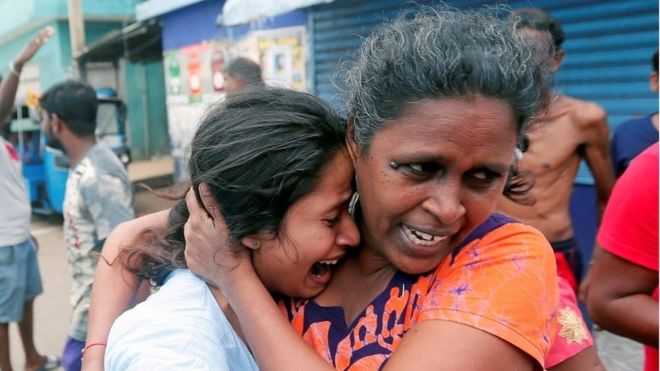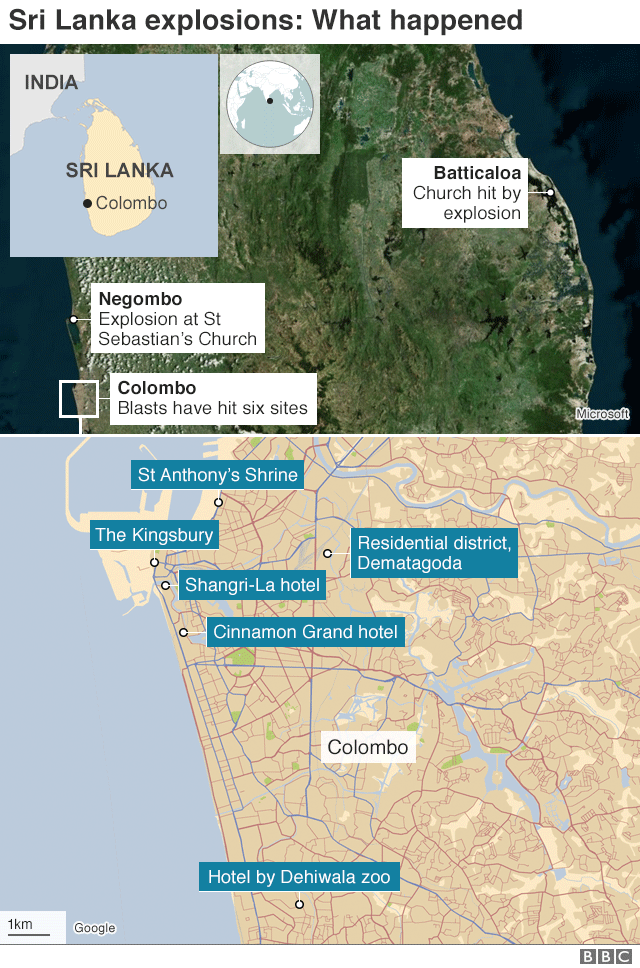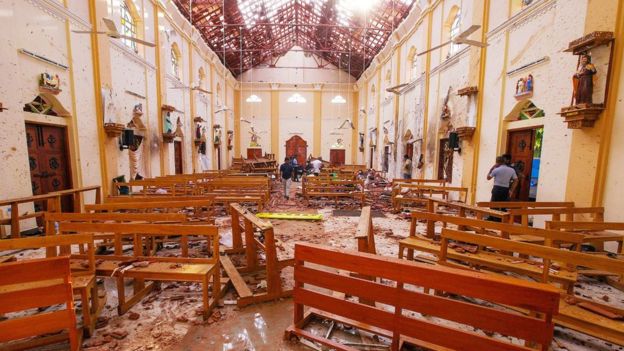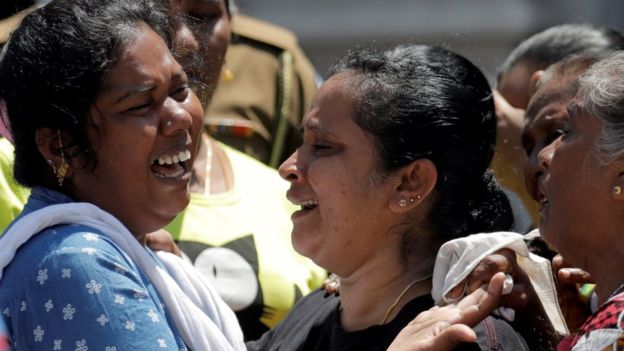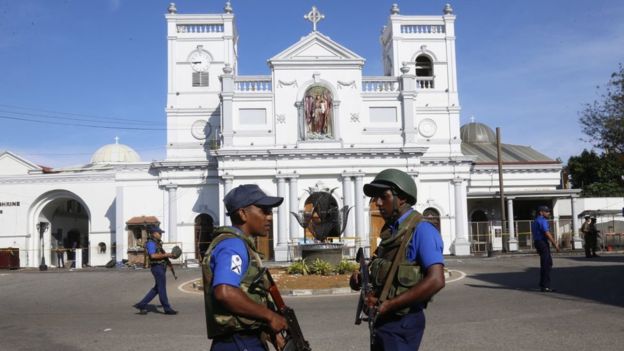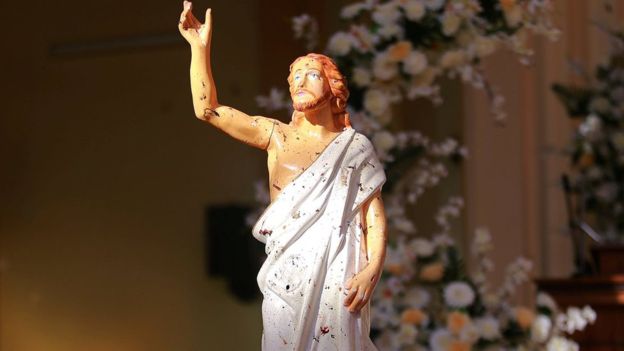On Easter Sunday, Sri Lanka was rocked by a series of bombings that killed more than 300 people at churches and top-end hotels.
It is the deadliest violence in the country since the end of the civil war a decade ago. Most of the victims are believed to be Sri Lankans, but at least 31 foreigners are among the dead too.
Police have made a number of arrests – although it remains unclear who was behind the attacks.
Here is what we know so far:
How did the attacks unfold?
The first reports were at about 08:45 (03:15 GMT) local time on Sunday morning, 21 April. Six blasts took place within a short space of time.
Three were at churches – in Colombo’s Kochchikade district, Negombo north of the capital, and Batticaloa in the east. The other three blasts rocked the Shangri-La, Kingsbury and Cinnamon Grand hotels in Colombo.
Two further explosions were reported later when police searched for suspects: one in Dehiwala in southern Colombo, and another one near the Colombo district of Dematagoda during a police raid.
The police have not given details about how many people died at each of the blast sites.
Late on Sunday, an improvised explosive device was found and disposed of close to the country’s main airport, near Colombo.
And on Monday another blast rocked a street near a church in the capital. Police were attempting to defuse explosives in a vehicle used by the attackers when it blew up.
On Monday morning, the official death toll given by authorities stood at 290, a sharp jump from about 200 deaths that had been reported by Sunday night. The final report was doomed to be even more tragic.
There are more than 500 injured and the death toll might still rise.
Hundreds of Sri Lankan families are in mourning. One of the first victims was celebrity chef Shantha Mayadunne. Other Sri Lankans killed included members of church congregations and staff at the hotels targeted.
The confirmed international casualties are from the UK, Denmark, Portugal, India, Turkey, Australia, the Netherlands, Japan, the US and China.
Among the dead are three children of Danish billionaire Anders Holch Povlsen, owner of the Bestseller clothing chain and a the largest stake holder in clothing giant Asos.
Who was behind the attacks?
It’s still not clear. Western mainstream mass media is trying to exclude anyhow the Islamist trace but it seems hard as the attacks show the clear fingerprint of the Religion of Peace.
On Monday the Sri Lankan authorities said they believe a little-known local Islamist group known as National Thowheed Jamath was behind them – and said officials were investigating about their “international ties”.
The group has no history of large-scale attacks but came to prominence last year when it was blamed for damaging Buddhist statues.
Addressing reports that officials had had prior intelligence of forthcoming attacks, Prime Minister Ranil Wickremesinghe said: “We must look into why adequate precautions were not taken. Neither I nor the ministers were kept informed.”
Police have arrested 24 people and said all the attacks were carried out by suicide bombers. No information has been given on the identity of those arrested.
Sri Lanka’s history and religion
Sunday’s attacks were the worst ever against Sri Lanka’s small Christian minority, who make up just 7% of the 21 million population.
Theravada Buddhism is Sri Lanka’s biggest religious group, making up about 70% of the population. Hindus and Muslims make up around 12% and 10% of the population respectively.
The attacks are Sri Lanka’s deadliest act of violence since the end of the country’s 26-year civil war in 2009.
Who are National Thowheed Jamath?
A previously little-known group called the National Thowheed Jamath (NTJ) is being accused of having carried out the Easter Sunday attacks in Sri Lanka.
The allegation raises the question, who are NTJ?
Origins
Until Monday, when the Sri Lankan government spokesman mentioned their name, very few people had heard of the NTJ.
The group is believed to have splintered off from another hardline Islamist group in the country, the Sri Lanka Thowheed Jamath (SLTJ).
While still relatively unknown, the SLTJ is a bit more established. Their secretary, Abdul Razik, was arrested in 2016 for inciting hatred against Buddhists. He later issued an apology.
Some reports have also linked the NTJ to a spate of vandalism last December that targeted Buddhist temples in Mawanella, central Sri Lanka. Then, they attacked the faces of Buddha statues that were on display outside the temples.
But they are an extremist fringe group within an already small religious minority – only 9.7% of Sri Lanka’s population of about 21 million are Muslim.
Their social media presence is sparse, too. Although they have a Facebook page, it is only updated every few weeks or so. Their Twitter page hasn’t been updated since March 2018.
The group’s website is also offline – although it’s not clear if it was taken down before or after Sunday’s attacks.
Links to the attacks
Government spokesman Rajitha Senaratne told reporters in Colombo on Monday that there had been “several warnings from foreign intelligence agencies about the impending attacks”.
This isn’t the only claim that officials had been alerted.
Sri Lankan telecommunications minister, Harin Fernando, tweeted a document that was reportedly sent by Sri Lanka’s police chief earlier this month.
In that, the NTJ are explicitly named – as well as a warning that the group was planning to attack churches and the Indian High Commission.
The document also names Mohamed Zahran, the group’s leader.
Alan Keenan, Sri Lanka director for the International Crisis Group, also told BBC 5Live that NTJ “appears to be the same group” as those behind the Mawanella vandalism.
He added: “The police eventually arrested a group of young men who were said to have been the students of a preacher who’s named in the intelligence document that came out Sunday.”
But given how small NTJ are, officials suspect that they weren’t acting alone.
“We don’t see that only a small organisation in this country can do all that,” Mr Senaratne said. “We are now investigating the international support for them, and their other links, how they produced the suicide bombers here, and how they produced bombs like this.”
And while not naming the NTJ directly, the Sri Lankan president’s office echoed this belief that whichever group was behind the attacks had help from abroad.
“The intelligence sections have reported that there are international terror groups which are behind the local terrorists,” a statement from President Maithripala Sirisena said. “International assistance will be sought to combat them.”
Article source: BBC
